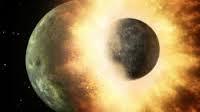The day the earth exploded
Van Westeren said that taken at face value, the findings suggest that the moon was once part of the Earth that was blasted into space by an enormous explosion from the Earth's fiery core. To do this, he believes that there must have been a 'massive energy kick' delivered quickly and he calculates that the explosion was the strength of 40 billion atomic bombs the size of those dropped on Hiroshima.
The idea that the Earth's core harbours a huge nuclear reactor has been around for over 60 years.There is also evidence of much smaller natural fossil reactors up to 10 metres across in West Africa that were active around 10 billion years ago. Van Westeren said that: 'A nuclear blast is the only thing we could come up with that could produce the necessary energy quickly enough' to blast the moon into space.
Scientists have reasoned that heavy elements like uranium and plutonium in heavy rocks sank deep into the Earth after it was formed and collected on its outer core where they formed large liquid reservoirs. The radioactive material in the rocks set off mini reactions, which when combined with enough fuel, produced an enormous explosion.
This theory of an internal nuclear reactor could explain why Earth gives out more energy than it receives from the sun. However, experts have said that even if evidence of 'global georeactors' was found, many scientists would need convincing that they were capable of creating the moon.
There are many conflicting ideas of exactly how the moon came to be and scientists are starting to re-question older theories. Matija Cuk, a planetary scientist at Harvard University said: 'I don't think you can separate the moon's formation from a giant impact.' But he draws upon Darwin's idea and the big splat and believes that a peculiar alignment of the sun, earth and moon is the reason why the moon orbits the Earth.
Sarah Griffiths

